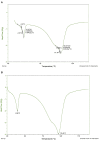Physical characterization of frozen fruits from eight cultivars of the North American pawpaw (Asimina triloba)
- PMID: 36330137
- PMCID: PMC9622945
- DOI: 10.3389/fnut.2022.936192
Physical characterization of frozen fruits from eight cultivars of the North American pawpaw (Asimina triloba)
Abstract
Pawpaw (Asimina triloba [L.] Dunal) is an underutilized fruit native to North America. The fruit has a short shelf life, and browns and softens rapidly after harvesting. These characteristics present a challenge to the advancement of pawpaw as an economically viable specialty crop. This study evaluated the physical characteristics of frozen fruits from eight cultivars of the pawpaw fruit to establish the processing potential of pawpaw fruits. The results show that freeze-thaw cycle may have influenced the peel thickness, peel color, and pulp color of the fruits. Fruits of the Susquehanna cultivar had the highest fruit weight and pulp weight, making them potentially the most suitable for pulp processing. The pawpaw fruits had almost neutral pH ranging between 6.07 ± 0.21 and 6.47 ± 0.11, which could contribute to the rapid browning on exposure to air since an acidic pH is important for slowing enzymatic browning. To aid pawpaw juice extraction, enzymatic treatments may be necessary to increase the juice yield from the pulp. Overleese fruits may be the best for pawpaw juice production. These findings can aid in the selection of processing equipment and guide processors in their efforts to utilize pawpaw fruits to avoid postharvest and post-processing losses.
Keywords: Annonaceae; Asimin triloba; pawpaw; pawpaw processing; tropical fruit.
Copyright © 2022 Adainoo, Crowell, Thomas, Lin, Cai, Byers, Gold and Krishnaswamy.
Conflict of interest statement
The authors declare that the research was conducted in the absence of any commercial or financial relationships that could be construed as a potential conflict of interest.
Figures






References
-
- Ames GK. Pawpaw – A “Tropical” Fruit. NCAT Horticulture. (2010) Available online at: https://attra.ncat.org/wp-content/uploads/2019/05/pawpaw.pdf (accessed October 12, 2021).
-
- Nam JS, Jang HL, Rhee YH. Nutritional compositions in roots. twigs, leaves, fruit pulp, and seeds from pawpaw (Asimina triloba [L.] Dunal) grown in Korea. J Appl Bot Food Qual. (2018) 91:47–55. 10.5073/JABFQ.2018.091.007 - DOI
-
- Ortutu SC, Aremu MO, Bako SS, State T. Comparison of antioxidant capacity of mango (Mangifera indica), pawpaw (Asimina triloba) and guava (Psidium guajava) pulp extracts at different maturation stages. Chem Mater Res. (2015) 7:20–9.
-
- Peterson RN. Pawpaw (Asimina). Acta Hortic. (1990) 290:567–600.
LinkOut - more resources
Full Text Sources

